
A series of pages exploring
various aspects of enslavement in Pennsylvania
 |
A series of pages exploring |
|
Enslavement in Lancaster CountyAdvertisements to Buy or Sell Enslaved Persons |
||
 Lancaster Intelligencer and Journal, 11 August, 1798. Lancaster, Pennsylvania From August 1798. Text of Ad: Wanted to purchase, An anonymously placed advertisement from eighteen years after the Gradual Abolition Act of 1780. The buyer is seeking an enslaved girl or woman. While eighteenth century laws recognized a free married female as a legal adult, or woman, at age twenty-one, the terms "girl" and "woman" were not clearly defined for persons in the lowest servant classes. An enslaved "girl" might be as young as a pre-teen or as old as a female in her middle twenties, while the term "woman" probably indicated a female twenty-one years of age and older. An enslaved female of about 18 years old or younger in August 1798 would probably be a "term slave" or a person enslaved until age 28. An enslaved female aged 19 and older was more likely to be a slave "for life," per the Gradual Abolition Act. As the holding of enslaved persons was becoming less socially acceptable by this time in Lancaster County, it is not surprising that the buyer preferred to remain anonymous by having sellers contact them by going through the newspaper printer. |
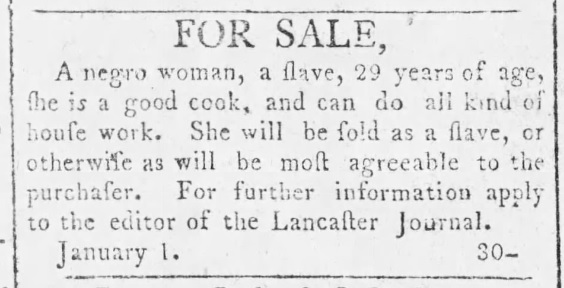 Lancaster Intelligencer, 5 February, 1803; page 4. Lancaster, Pennsylvania From January 1803. Text of Ad: FOR SALE,This ad was repeated, with the descriptive word "valuable" added, in March. The woman in this ad would have been born about 1774, six years prior to passage of the Gradual Abolition law. The slaveholder, who remains anonymous by having the purchaser work through the editor, affects a humanitarian air by noting she may be "sold as a slave, or otherwise." |
 Lancaster Intelligencer, 5 February, 1803; page 4. Lancaster, Pennsylvania Also from January 1803, this ad appeared on the same page as the one above. Text of ad: FOR SALE, The woman in this ad is likely a slave for life. "Recorded according to law" indicates this or a previous slaveholder made a return to the county clerk as stipulated by the Gradual Abolition law of 1780. Had she not been so "recorded," her enslavement would not have been recognized by law and it would have been illegal to attempt to sell her. |
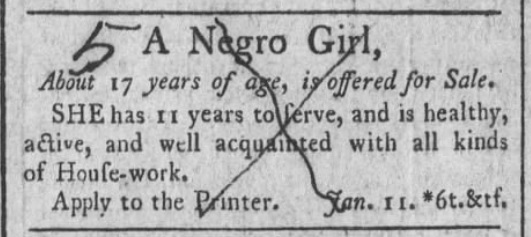 Lancaster Intelligencer, 3 March, 1803; page 4. Lancaster, Pennsylvania From March 1803. Text of ad: A Negro Girl, The teenaged girl in this ad was born about 1786 and is therefore enslaved to age 28. The inked "x" and "5" over the ad were likely from the printer, added to a print shop copy to plan the next edition. |
 Lancaster Journal, 29 April, 1813; page 4. Lancaster, Pennsylvania An ad from April 1813. Text of ad: For Sale, Unlike many ads of this period, the slaveholder, Robert Elliott, identifies himself. In addition, we know the name of this enslaved young man, Vachel Brown, although we don't know exactly how old he is. The description "yellow boy" indicates a light-skinned male, probably less than twenty-one years of age. The duties of waiter and hostler suggest the current slaveholder is either the owner of a large estate, or possibly the owner of an inn or hotel. The character description "well disposed" is code for a compliant personality. |
 Lancaster Journal Extra, 16 September, 1814; page 5. Lancaster, Pennsylvania Text of ad: For Sale, The "girl" in this July 1814 ad may be as old as twenty, although we don't know since her current age is not stated. The terms "stout" and "healthy" refer to her ability to handle heavy house or farm work. |
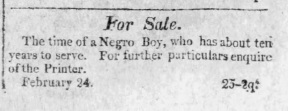 Lancaster Journal, 3 March, 1815; page 4. Lancaster, Pennsylvania From February 1815. Text of ad: For Sale. Like the ad above, very brief and to the point. The wording is of interest. Offering for sale "The time of" this enslaved person was no different from simply offering to sell the person, who, like all born to an enslaved Black mother after March 1780, was enslaved for a term of years instead of for life. |
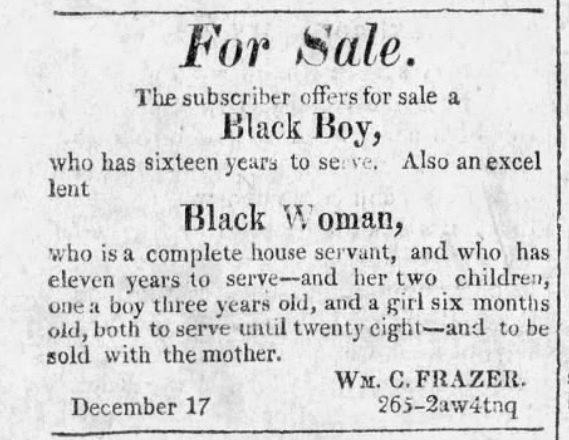 Lancaster Journal, 19 December, 1817; page 1. Lancaster, Pennsylvania From December 1817, this ad ran at least through early January 1818. Text of ad: For Sale. Lawyer William Clark Frazer, 1776-1836, studied law in Lancaster and in 1836 was appointed to the Wisconsin Territorial Supreme Court. He was born in New Castle, Delaware, where he established his first law office, and on April 22, 1813 advertised that he "has commenced the practice of LAW in the borough of Lancaster, and now resides in the house lately occupied by William Jenkins, Esq. North Queen street, opposite Mr. George Weaver's tavern." (Lancaster Journal, 29 April 1813, page 4) He apparently enslaved numerous people, as in addition to the four in this advertisement, in February 1818 offered two teenaged "Negro Boys," one of which might be the same young man mentioned first in this ad. (See that listing, here) The woman and her two young children are all term slaves. The difference in their remaining years of enslavement clearly illustrates the impractical and inhumane aspect of the law. When the woman's term of enslavement ends and she legally becomes free, her children will still be enslaved for fourteen and seventeen years respectively. At that point she would either have to leave her children or, to stay with them, be forced to continue living in her enslaver's household even though free. |
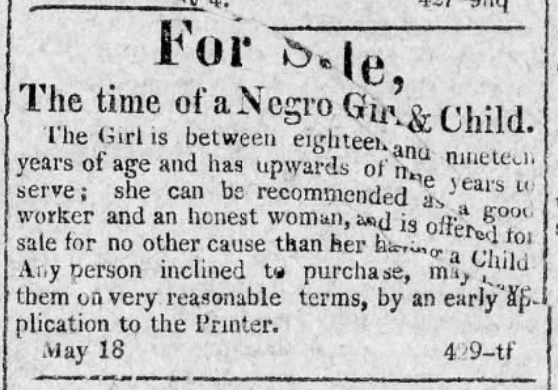 Lancaster Journal, 25 May, 1818; page 1. Lancaster, Pennsylvania From May 1818. Text of ad: For Sale, This ad is for a teenaged girl, born about the year 1799 or 1800 and enslaved to age 28. The enslaver, who maintains anonymity by having potential purchasers go through the printer, no longer wants her because she now has a child to take up part of her time as opposed to devoting all of her time to her usual chores and duties. Note that the ad states "time of a Negro Girl & Child," indicating that the child has inherited the enslaved status of its mother, which is in direct conflict with the intent of the Gradual Abolition Law because it preserves the cycle of enslavement that the law was written to dismantle. |
Afrolumens Project Home | Enslavement Main Page | Lancaster County Index Page
Original material on these pages copyright 2023 Afrolumens Project.